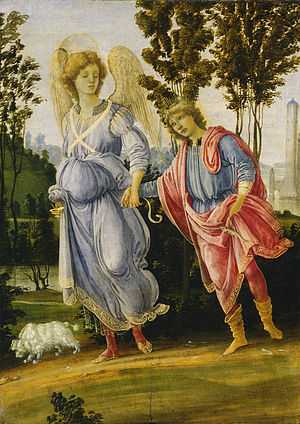Tobias and the Angel (Filippino Lippi)
 | |
| Artist | Filippino Lippi |
|---|---|
| Year | 1475–1480 |
| Type | Oil and tempera on panel |
| Dimensions | 32.7 cm × 23.5 cm (12.9 in × 9.3 in) |
| Location | National Gallery of Art, Washington |
Tobias and the Angel is a painting by the Italian Renaissance painter Filippino Lippi, dating from c. 1475-1480. It is housed in the National Gallery of Art of Washington, DC.
The painting is based on the story of Tobit of Nenevah from the Book of Tobit. Tobit is described as a man of good faith who suffers from blindness and poverty. He sent his son, Tobias, to a distant city to collect money he had deposited there, and hired a companion to accompany the youth. The companion was actually the archangel Raphael in disguise. Their journey was successful: not only was the money recovered, but medicine made from a monstrous fish Tobias encounters along the way cures Tobit's blindness.
In Hebrew, Raphael's name means "God has healed". In this painting, Raphael holds a golden mortar used for compounding medicinal ingredients. Although the archangel is usually shown with a mortar or medicine box, his identity here is established by the presence of Tobias holding a fish. Raphael is named only in the Book of Tobit.
The story of Tobit may have been particularly popular in 15th century Florence because of its appeal to merchant families, whose sons were often sent to trade in far-away cities. Paintings of Tobias and his angelic guardian were likely commissioned as dedications to ensure a safe journey, or offer thanks for a safe return. The painting's suggestion of reward for fair dealing may have been equally welcome.
See also
- The Three Archangels with Tobias